-
 Bitcoin
Bitcoin $83,418.1551
-0.31% -
 Ethereum
Ethereum $1,808.8979
-0.41% -
 Tether USDt
Tether USDt $0.9999
0.02% -
 XRP
XRP $2.1463
1.00% -
 BNB
BNB $593.3907
-0.49% -
 Solana
Solana $120.0979
-1.63% -
 USDC
USDC $1.0001
0.00% -
 Dogecoin
Dogecoin $0.1689
-0.83% -
 Cardano
Cardano $0.6536
-1.17% -
 TRON
TRON $0.2370
-0.75% -
 Chainlink
Chainlink $12.8454
-0.75% -
 UNUS SED LEO
UNUS SED LEO $9.1245
-0.51% -
 Toncoin
Toncoin $3.2503
-4.22% -
 Stellar
Stellar $0.2527
-2.58% -
 Avalanche
Avalanche $17.8357
-1.69% -
 Shiba Inu
Shiba Inu $0.0...01231
-0.09% -
 Sui
Sui $2.2068
-1.49% -
 Hedera
Hedera $0.1623
-0.93% -
 Litecoin
Litecoin $82.5360
-2.34% -
 Polkadot
Polkadot $3.9567
-1.88% -
 Bitcoin Cash
Bitcoin Cash $306.9330
1.70% -
 MANTRA
MANTRA $6.2879
0.30% -
 Dai
Dai $1.0001
0.01% -
 Bitget Token
Bitget Token $4.4588
-1.48% -
 Ethena USDe
Ethena USDe $0.9992
0.01% -
 Pi
Pi $0.6376
24.33% -
 Hyperliquid
Hyperliquid $11.9460
0.08% -
 Monero
Monero $213.4997
-0.58% -
 Uniswap
Uniswap $5.8533
-0.79% -
 OKB
OKB $52.7441
6.99%
How are transactions in a blockchain verified?
Blockchain transaction verification involves miners/validators using consensus mechanisms (like Proof-of-Work or Proof-of-Stake) to add verified blocks of cryptographically hashed transactions to the chain, ensuring data integrity and preventing double-spending.
Mar 18, 2025 at 10:36 am
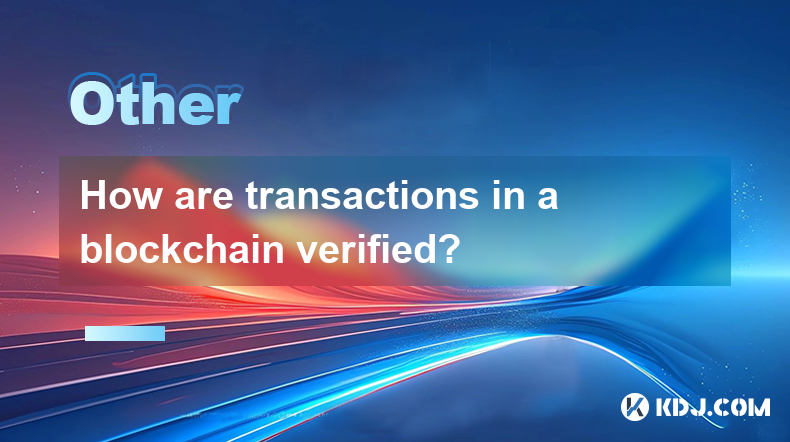
How are Transactions in a Blockchain Verified?
Key Points:
- The Role of Miners/Validators: The core of blockchain transaction verification lies in the work of miners (in Proof-of-Work blockchains like Bitcoin) or validators (in Proof-of-Stake blockchains like Ethereum). These entities compete to add new blocks of transactions to the chain.
- Consensus Mechanisms: Different blockchains use different consensus mechanisms to ensure agreement on the valid state of the blockchain. Proof-of-Work, Proof-of-Stake, and Delegated Proof-of-Stake are prominent examples. Each mechanism has its unique verification process.
- Cryptographic Hashing: Cryptographic hashing is crucial. Each transaction and block is assigned a unique hash, ensuring its integrity. Any alteration to a transaction or block will result in a completely different hash, making tampering immediately detectable.
- Transaction Broadcasting and Propagation: Transactions are first broadcast across the network. Nodes receive and verify these transactions before including them in a proposed block.
- Block Creation and Verification: Miners/validators group verified transactions into blocks. The process of creating a valid block varies based on the consensus mechanism. Other nodes then verify the block's validity before adding it to their copy of the blockchain.
- Step 1: Transaction Initiation and Broadcasting
A cryptocurrency transaction begins when a user initiates a transfer of funds from their wallet to another address. This transaction includes crucial details like the sender's address, the recipient's address, the amount of cryptocurrency being transferred, and a unique transaction ID. The transaction is then broadcast to the peer-to-peer network of nodes that make up the blockchain. This broadcasting is crucial for transparency and decentralization; the transaction isn't sent to a central authority but instead shared with the entire network. The process utilizes various protocols, ensuring efficient and reliable dissemination of the transaction information. Nodes within the network utilize algorithms and data structures to verify the transaction’s legitimacy. For instance, they check whether the sender has enough funds in their account to cover the transaction. The process also involves validating the digital signatures associated with the transaction, confirming the sender's identity and preventing unauthorized transactions. Failure at this stage would prevent the transaction from being included in a block and thus becoming part of the blockchain's permanent record. The sheer volume of transactions being broadcast concurrently necessitates sophisticated networking strategies. These strategies, including network topology optimizations and distributed consensus protocols, are vital for efficient and secure handling of the transaction data across the decentralized network. The robustness of this broadcasting mechanism is crucial for the entire operation of the blockchain system; without it, transactions would remain isolated and unable to propagate through the network. Moreover, the broadcast mechanism must be resistant to attacks, such as Sybil attacks, where malicious actors flood the network with fraudulent transactions.
- Step 2: Transaction Verification by Nodes
Once a transaction is broadcast, numerous nodes in the network independently verify its validity. This independent verification is a cornerstone of blockchain security, ensuring that no single entity controls the validation process. Each node checks the transaction's digital signature to confirm that the sender indeed authorized the transfer. The node also verifies that the sender has a sufficient balance to cover the transaction fees and the amount being sent. This involves accessing the blockchain's ledger, which is a public record of all previous transactions. The node then calculates a cryptographic hash of the transaction. This hash is a unique fingerprint of the transaction, and any alteration to the transaction data will result in a different hash. The node compares this calculated hash with the hash provided in the transaction. A mismatch indicates tampering, invalidating the transaction. This process, combined with the cryptographic hashing algorithm’s properties, ensures the integrity and immutability of the transaction. The verification process also includes checks for double-spending, ensuring that the same cryptocurrency isn't spent twice. This is achieved through the meticulous tracking of every transaction and its impact on each address's balance. Sophisticated algorithms and data structures are employed to optimize the search and verification process across the massive transaction history of the blockchain. The complexity of these checks underscores the technological sophistication underlying blockchain's security and reliability.
- Step 3: Block Creation and the Role of Miners/Validators
Verified transactions are grouped together into blocks. The process of creating these blocks differs depending on the blockchain's consensus mechanism. In Proof-of-Work (PoW) blockchains, like Bitcoin, miners compete to solve complex cryptographic puzzles. The first miner to solve the puzzle adds the block of verified transactions to the blockchain and receives a reward in cryptocurrency. This process requires significant computational power, acting as a security mechanism against malicious actors. The difficulty of the puzzle adjusts dynamically to maintain a consistent block creation rate. In Proof-of-Stake (PoS) blockchains, like many newer iterations of Ethereum, validators are chosen to create blocks based on the amount of cryptocurrency they stake. This mechanism is generally more energy-efficient than PoW. The selected validator creates a block containing the verified transactions and proposes it to the network. Other validators then verify the block's validity and its inclusion of correctly verified transactions. This verification includes checks for the validity of the block’s cryptographic hash and its adherence to the blockchain's rules and protocols. The consensus mechanism ensures that only valid blocks are added to the blockchain, maintaining its integrity. The intricacies of block creation and the various algorithms used underscore the sophistication involved in maintaining the integrity and security of the blockchain system. The selection process for validators and miners is also designed to be fair and transparent, preventing any single entity from dominating the process. The process ensures that the blockchain remains a decentralized and secure system.
- Step 4: Block Propagation and Network Consensus
Once a block is created, it is broadcast to the network. Other nodes verify the block's validity independently, checking the cryptographic hash, transaction signatures, and adherence to the consensus mechanism's rules. This independent verification is crucial for ensuring the integrity of the blockchain. If a node detects an error, it will reject the block. However, if a sufficient number of nodes validate the block, it's added to their copy of the blockchain. This process achieves consensus, ensuring that all nodes have a consistent view of the blockchain's state. The consensus mechanism dictates the required level of agreement for a block to be accepted. In PoW, it's usually based on the computational power supporting the block. In PoS, it's often based on the stake weighted votes of validators. The complexity of this propagation and consensus process is immense, especially considering the size and distributed nature of the blockchain network. Sophisticated algorithms and protocols are essential for ensuring that blocks are efficiently propagated across the network, minimizing latency and maximizing security. The entire process is designed to be robust against various attacks, ensuring the immutability and reliability of the blockchain. The decentralized nature of this step also makes the blockchain resistant to single points of failure.
- Step 5: Permanent Recording and Immutability
Once a block is accepted by a significant portion of the network, it becomes a permanent part of the blockchain. This immutability is a key feature of blockchain technology, making it difficult to alter or delete transactions. The cryptographic hashing and the consensus mechanism ensure that any attempt to modify a block would be easily detectable and rejected by the network. This characteristic makes blockchain an ideal system for recording transactions securely and transparently. The immutability ensures the integrity of the data stored on the blockchain, making it highly trustworthy. This trust is essential for the adoption of blockchain technology in various applications, ranging from financial transactions to supply chain management. The process of adding a block to the blockchain and making it immutable involves sophisticated cryptographic techniques, data structures, and consensus algorithms, which together create a robust and secure system. The distributed nature of the blockchain further strengthens its immutability, making it highly resistant to attacks and manipulations.
FAQs:
Q: What is a cryptographic hash, and why is it important in blockchain verification?
A: A cryptographic hash is a one-way function that transforms data of any size into a fixed-size string of characters. In blockchain, each transaction and block is assigned a unique hash. Even a tiny change to the data results in a completely different hash. This ensures data integrity; any tampering would be immediately detectable because the calculated hash would not match the stored hash.
Q: How does the blockchain prevent double-spending?
A: Double-spending is prevented through a combination of factors. Firstly, every transaction is broadcast to the network, allowing multiple nodes to verify it simultaneously. Secondly, the consensus mechanism ensures that only one version of the blockchain (the longest chain, typically) is accepted, preventing fraudulent transactions from being added to the main chain. Finally, the immutable nature of the blockchain prevents the reversal or alteration of past transactions.
Q: What are the differences between Proof-of-Work and Proof-of-Stake?
A: Proof-of-Work (PoW) relies on miners competing to solve complex computational puzzles to add blocks to the blockchain. It's energy-intensive but provides high security. Proof-of-Stake (PoS) selects validators to create blocks based on their staked cryptocurrency, making it more energy-efficient but potentially susceptible to attacks if a large portion of the stake is controlled by a single entity.
Q: What happens if a node detects a fraudulent transaction?
A: If a node detects a fraudulent transaction, it will reject the transaction and not include it in the block it proposes. The consensus mechanism ensures that only valid transactions are added to the blockchain. The network's distributed nature means that even if some nodes accept a fraudulent transaction, the majority will reject it, preventing it from becoming part of the main blockchain.
Q: How is the security of the blockchain maintained?
A: Blockchain security is multifaceted. It relies on cryptographic hashing to ensure data integrity, consensus mechanisms to prevent fraudulent transactions, and the decentralized nature of the network to make it resistant to single points of failure or attacks. The constant verification and validation by numerous nodes throughout the network contribute significantly to the overall security.
Disclaimer:info@kdj.com
The information provided is not trading advice. kdj.com does not assume any responsibility for any investments made based on the information provided in this article. Cryptocurrencies are highly volatile and it is highly recommended that you invest with caution after thorough research!
If you believe that the content used on this website infringes your copyright, please contact us immediately (info@kdj.com) and we will delete it promptly.
- Will XRP Hold $2 or Drop to $1?
- 2025-04-06 07:40:12
- title: U.S. stock index futures dipped on Tuesday, signaling a cautious start to the new quarter
- 2025-04-06 07:40:12
- VeChain (VET) Price Prediction: Can the 98% Surge Continue?
- 2025-04-06 07:35:12
- Ethereum (ETH) Price Could Break $3,000 If Historical Trends Continue
- 2025-04-06 07:35:12
- EU Announces Support for IOTA as the Core Technology for Web3 Digital Identity, ePassports and MiCA
- 2025-04-06 07:30:12
- Cardano (ADA) Founder Charles Hoskinson Reveals Plans to Turbocharge Bitcoin's Integration into Decentralized Finance
- 2025-04-06 07:30:12
Related knowledge

Is the ranking of Chinese blockchain apps real and reliable?
Apr 04,2025 at 09:01pm
The ranking of Chinese blockchain apps has become a topic of interest for many in the cryptocurrency community, as it provides insights into the popularity and adoption of blockchain technology within China. However, the reliability and authenticity of these rankings are often questioned. This article aims to delve into the factors that influence these ...
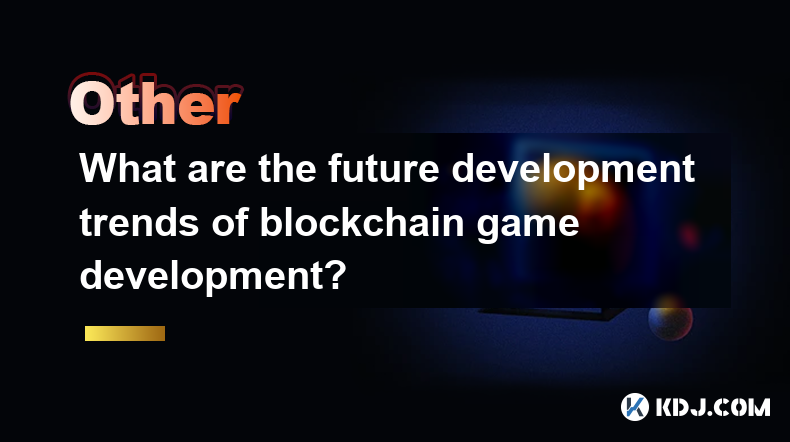
What are the future development trends of blockchain game development?
Apr 03,2025 at 05:00am
Blockchain technology has revolutionized various industries, and gaming is no exception. As we look to the future, several trends are set to shape the development of blockchain games. These trends not only promise to enhance the gaming experience but also to integrate blockchain technology more seamlessly into the gaming ecosystem. Let's explore these t...

What are the high-return opportunities for blockchain investments?
Apr 05,2025 at 02:35pm
Blockchain technology has revolutionized the financial world, offering numerous high-return investment opportunities. These opportunities span various sectors within the cryptocurrency ecosystem, including cryptocurrencies, decentralized finance (DeFi), non-fungible tokens (NFTs), and blockchain startups. Each of these areas presents unique risks and re...
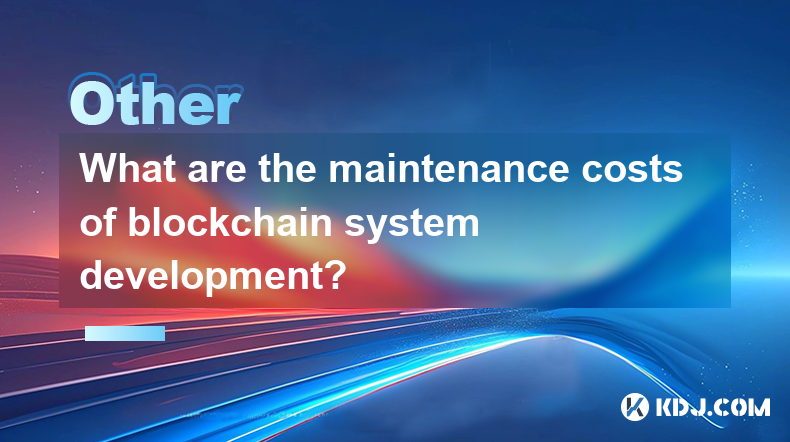
What are the maintenance costs of blockchain system development?
Apr 03,2025 at 06:07pm
The maintenance costs of blockchain system development are multifaceted and depend on various factors. These costs can include technical maintenance, security updates, infrastructure expenses, and personnel costs. Understanding these elements is crucial for anyone planning to develop or maintain a blockchain system. Technical MaintenanceTechnical mainte...
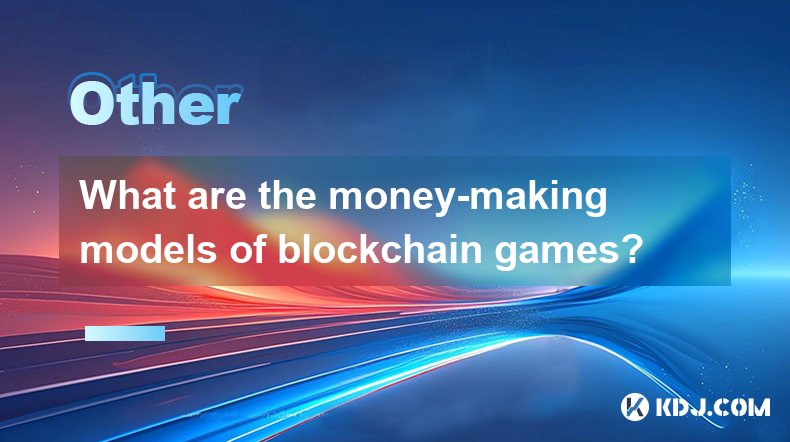
What are the money-making models of blockchain games?
Apr 04,2025 at 02:00pm
Blockchain games have emerged as a revolutionary way for players to earn real money while enjoying their favorite pastime. These games leverage the power of blockchain technology to create unique money-making models that benefit both the players and the developers. In this article, we will explore the various money-making models of blockchain games and ...
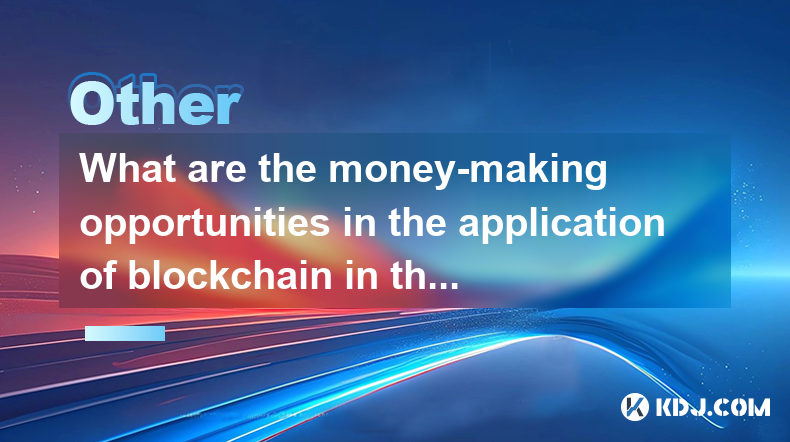
What are the money-making opportunities in the application of blockchain in the field of Internet of Things?
Apr 05,2025 at 10:35pm
The integration of blockchain technology with the Internet of Things (IoT) presents numerous money-making opportunities. Blockchain, with its decentralized and secure nature, can revolutionize how IoT devices interact, manage data, and conduct transactions. This article will explore various avenues where entrepreneurs, developers, and investors can capi...

Is the ranking of Chinese blockchain apps real and reliable?
Apr 04,2025 at 09:01pm
The ranking of Chinese blockchain apps has become a topic of interest for many in the cryptocurrency community, as it provides insights into the popularity and adoption of blockchain technology within China. However, the reliability and authenticity of these rankings are often questioned. This article aims to delve into the factors that influence these ...

What are the future development trends of blockchain game development?
Apr 03,2025 at 05:00am
Blockchain technology has revolutionized various industries, and gaming is no exception. As we look to the future, several trends are set to shape the development of blockchain games. These trends not only promise to enhance the gaming experience but also to integrate blockchain technology more seamlessly into the gaming ecosystem. Let's explore these t...

What are the high-return opportunities for blockchain investments?
Apr 05,2025 at 02:35pm
Blockchain technology has revolutionized the financial world, offering numerous high-return investment opportunities. These opportunities span various sectors within the cryptocurrency ecosystem, including cryptocurrencies, decentralized finance (DeFi), non-fungible tokens (NFTs), and blockchain startups. Each of these areas presents unique risks and re...

What are the maintenance costs of blockchain system development?
Apr 03,2025 at 06:07pm
The maintenance costs of blockchain system development are multifaceted and depend on various factors. These costs can include technical maintenance, security updates, infrastructure expenses, and personnel costs. Understanding these elements is crucial for anyone planning to develop or maintain a blockchain system. Technical MaintenanceTechnical mainte...

What are the money-making models of blockchain games?
Apr 04,2025 at 02:00pm
Blockchain games have emerged as a revolutionary way for players to earn real money while enjoying their favorite pastime. These games leverage the power of blockchain technology to create unique money-making models that benefit both the players and the developers. In this article, we will explore the various money-making models of blockchain games and ...

What are the money-making opportunities in the application of blockchain in the field of Internet of Things?
Apr 05,2025 at 10:35pm
The integration of blockchain technology with the Internet of Things (IoT) presents numerous money-making opportunities. Blockchain, with its decentralized and secure nature, can revolutionize how IoT devices interact, manage data, and conduct transactions. This article will explore various avenues where entrepreneurs, developers, and investors can capi...
See all articles





















































































